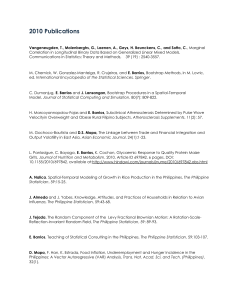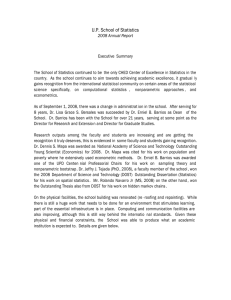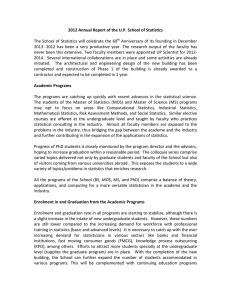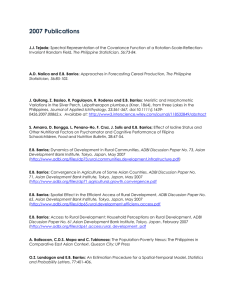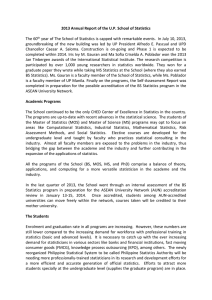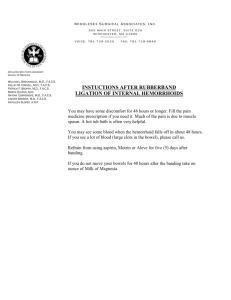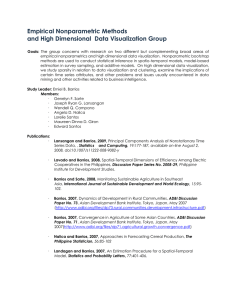2011 Annual Report of the U.P. School of Statistics
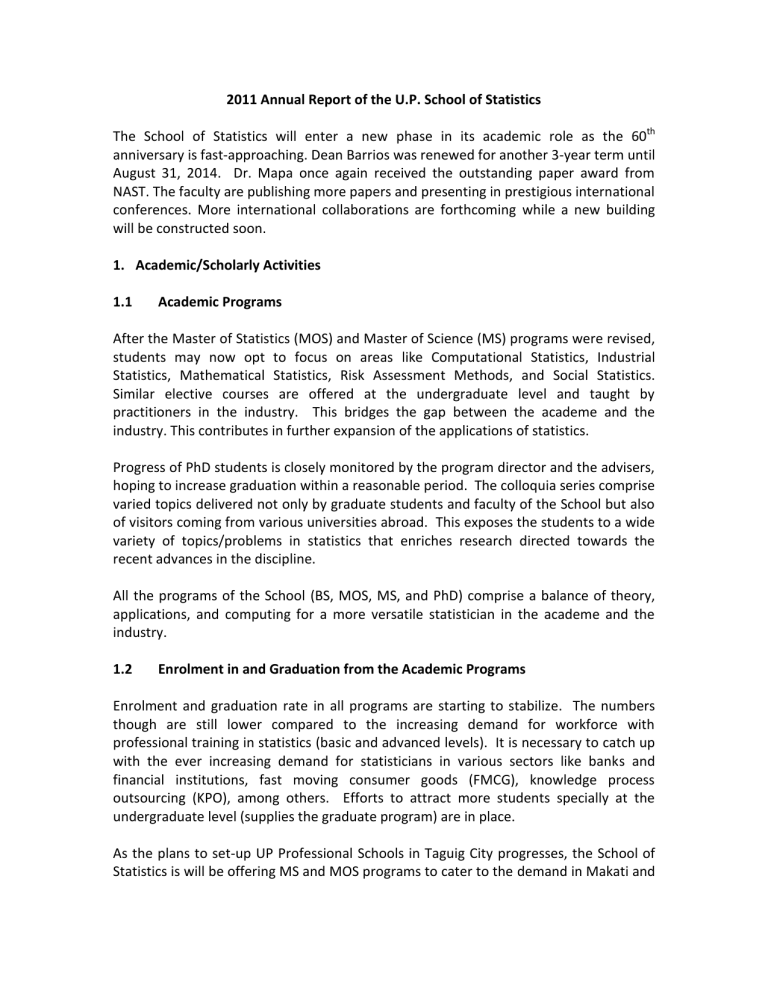
2011 Annual Report of the U.P. School of Statistics
The School of Statistics will enter a new phase in its academic role as the 60 th anniversary is fast-approaching. Dean Barrios was renewed for another 3-year term until
August 31, 2014. Dr. Mapa once again received the outstanding paper award from
NAST. The faculty are publishing more papers and presenting in prestigious international conferences. More international collaborations are forthcoming while a new building will be constructed soon.
1.
Academic/Scholarly Activities
1.1 Academic Programs
After the Master of Statistics (MOS) and Master of Science (MS) programs were revised, students may now opt to focus on areas like Computational Statistics, Industrial
Statistics, Mathematical Statistics, Risk Assessment Methods, and Social Statistics.
Similar elective courses are offered at the undergraduate level and taught by practitioners in the industry. This bridges the gap between the academe and the industry. This contributes in further expansion of the applications of statistics.
Progress of PhD students is closely monitored by the program director and the advisers, hoping to increase graduation within a reasonable period. The colloquia series comprise varied topics delivered not only by graduate students and faculty of the School but also of visitors coming from various universities abroad. This exposes the students to a wide variety of topics/problems in statistics that enriches research directed towards the recent advances in the discipline.
All the programs of the School (BS, MOS, MS, and PhD) comprise a balance of theory, applications, and computing for a more versatile statistician in the academe and the industry.
1.2 Enrolment in and Graduation from the Academic Programs
Enrolment and graduation rate in all programs are starting to stabilize. The numbers though are still lower compared to the increasing demand for workforce with professional training in statistics (basic and advanced levels). It is necessary to catch up with the ever increasing demand for statisticians in various sectors like banks and financial institutions, fast moving consumer goods (FMCG), knowledge process outsourcing (KPO), among others. Efforts to attract more students specially at the undergraduate level (supplies the graduate program) are in place.
As the plans to set-up UP Professional Schools in Taguig City progresses, the School of
Statistics is will be offering MS and MOS programs to cater to the demand in Makati and
south of Metro Manila area. This is expected to generate more enrollees in the graduate program and hopefully adding to the very lean number of statisticians with advanced training in statistics.
The distribution of enrollment and graduation by academic programs in the last five years are given below.
Distribution of Enrolled Students and Graduates by Program
Academic
Year
Enrolled
(Average per Semester) Number of Graduates
B.S. MOS MS Ph.D. B.S. MOS MS Ph.D.
2006-2007 424 94 71 21 85 7 2 0
2007-2008 379 82 75 20 83
2008-2009 368 67 64 22 80
2009-2010 360 68 52 22 94
2010-2011 373 70 45 19 85
8 7
7 10
3 12
4 7
1
1
1
0
1.2 Faculty
Two additional faculty items were added, bringing a total of 29 faculty members. While the faculty-student ratio is still high at 1:16, this is expected to go down once the request for additional faculty items will be granted. Many of the faculty members are in the graduate programs (MS or PhD) of the school. Dr. Cristina Remedios Sotto is continuing with her teaching post at Hasselt University in Belgium, but will be involved in mentoring of the junior faculty and graduate students. Four faculty members are pursuing PhD (Statistics) and 5 are pursuing MS (Statistics). The faculty is now composed of 29% with PhD, 54% with MS, 18% with BS (currently completing their MS program).
Prof. Lisa Grace S. Bersales was appointed as Vice President for Planning and Finance of the UP System. While this post is full-time, Prof. Bersales continues to mentor graduate students.
1.3 Research, Publications, Conferences
The list of publications in local and international journals is getting longer. Seven papers are published in ISI-indexed journals, two book chapters published by international publishers, and the rest are published in The Philippine Statistician and other journals.
There were also seven discussion papers published in the website. The discussion paper series is intended to elicit comments/suggestions for papers that are to be submitted for possible publications in some journals later.
The complete list of publications follows.
J. Guarte and E. Barrios , 2011, Nonparametric Hypothesis Testing in a Spatial-
Temporal Model: A Simulation Study, forthcoming, Communications in Statistics-
Simulation and Computing .
E. Santos and E. Barrios , 2011, Nonparametric Decomposition of Time Series Data with Inputs, forthcoming, Communications in Statistics-Simulation and Computing .
M. Mancenido and E. Barrios , An AR-Sieve Bootstrap Control Chart for Autocorrelated Process Data, forthcoming, Quality and Reliability
Engineering International .
J. Abrahantes , C. Sotto , G. Molenberghs, G. Vrommand, B. Bierinck , A comparison of
Various Software Tools for Dealing with Missing Data via Imputation, Forthcoming in
Journal of Statistical Computing and Simulation .
E. Reston and L. Bersales, Reform Efforts in Training Mathematics Teachers to Teach
Statistics: Challenges and Prospects, in Batanero, Burrill, Reading, eds., Teaching
Statistics in School Mathematics - Challenges for Teaching and Teacher Education ,
Heidelberg: Springer
L. Santos and E. Barrios , Small Sample Estimation in Dynamic Panel Data Models,
Open Journal of Statistics , 1(3):58-73.
E. Barrios, J. Lansangan and J. Daquis , Impact Assessment of the E-AGRIKultura
Project: Philippines, in D. Grimshaw and S. Kala, eds., Strengthening Rural
Livelihoods: The Impact of Information and Communication Technology in Asia ,
Warwickshire: Practical Action Publishing and International Development Research
Centre.
N. Duport, D. Goyeau, and G. Sarte, World Business Cycle, Local Specialization and
Asset Prices, Philippine Management Review , 18:51-70.
R. Bastero and E. Barrios, Robust Estimation of a Spatiotemporal Model with
Structural Change, Communications in Statistics-Simulation and Computation , 40
(3):448-468.
W. Campano and E. Barrios, Robust Estimation of a Time Series Model with
Structural Change, Journal of Statistical Simulation , 81(7): 909-927.
C. Sotto, C. Beunckens, G. Molenberghs, M. Kenward, MCMC-Based Estimation
Methods for Continuous Longitudinal Data with Non-Random (Non-) Monotone
Missingness, Computational Statistics and Data Analysis , 55 (1):301-311.
K. Santos and J. Salagubang, Investigating the Efficiency of Stratified Ranked Set
Sampling Using Nonparametric Bootstrap Estimation, The Philippine Statistician ,
60:15-30.
L. Bersales , 2011, Length of a Time Series for Seasonal Adjustment: Some Empirical
Experiments, The Philippine Statistician , 60:31-42.
D. Mapa , F. Han, and K. Estrada, Food Inflation, Underemployment and Hunger
Incidence: A Vector Autoregressive Analysis, The Philippine Statistician , 60:43-62.
H. Taima and A. Tabunda , 2011, Copula-Based Vector Autoregressive Models for
Bivariate Cointegrated Data, The Philippine Statistician , 60:105-124.
J. Lansangan , A Dose of Business Intelligence: Data Mining, The Philippine
Statistician , 60:125-128.
E. Barrios , Bootstrap Methods, The Philippine Statistician , 60:129-132.
E. Santos , D. Mapa , and E. Glindro, Estimating Inflation at Risk (IaR) using Extreme
Value Theory (EVT), DP 2011-01.
D. Mapa and M. Sandoval, The Economic Transition and Growth of Philippine
Regions, DP 2011-02.
E. De Vera and E. Barrios , Semiparametric Poisson Regression Model for Clustered
Data, DP 2011-03.
D. Mapa, L. Bersales, M. Albis and J. Daquis , Determinants of Poverty in Elderly-
Headed Households in the Philippines, DP 2011-04.
E. Barrios, J. Lansangan and J. Daquis , Impact Assessment of the e-Agrikultura
Project: Philippines, DP 2011-05.
E. Barrios and K. Manalaysay, Semiparametric Principal Components Poison
Regression on Clustered Data, DP 2011-06.
W. Campano and E. Barrios , Robust Methods in Time Series Models with Volatility,
DP 2011-07.
The following lectures were delivered in 2011:
G. Sarte, Multivariate Control Charts for Time Series Data
W. Patungan, Multivariate Regression with Mixed Data
J. Almeda, Mathematics Anxiety Scale for Filipino (MAS-FS): Testing for Reliability and Validity.
M. Albis, D. Mapa, L. Bersales, J. Daquis, Determinants of Poverty in Elderly-Headed
Households in the Philippines.
J. Umali and E. Barrios, Nonparametric Principal Components Regression.
J. Daquis and E. Barrios, Nonparametric Transfer Function Models with Localized
Temporal Effect.
E. Pena, Multiple Decision-Making in the Face of Uncertainty.
A. De Leon, Random Effects Copula Models for Clustered Mixed Outcomes.
J. Park, Spatial Linear Model for Computer Experiments: Subset Selection and Code
Tuning.
C. Elnas, A Space-Time Self-Exciting Threshold Autoregressive and Moving Average
Models.
A. Magallanes, Spatiotemporal Markov-Switching Epidemic Model.
R. Valenzuela, Evaluating the Distribution Implications of Price Movements:
Methodology, Applications and Australian Evidence.
Many papers were presented in prestigious international conferences. Prof. Barrios was invited speaker during the International Conference on Advances in Probability and
Statistics-Theory and Applications hosted by The Chinese University of Hongkong in honor of Prof. N. Balakrishnan’s 30 years of contributions to statistics. He presented the paper “Semiparametric Principal Components Poisson Regression on Clustered Data” co-authored with K. Manalaysay. Prof. Almeda presented the paper “Mathematics
Anxiety Scale for Filipino Students: Reliability, Validity, and Bias Detection” in the 2011
International Meeting of the Psychometric Society in Hongkong. Manuel Albis presented “Determinants of Poverty in Elderly-Headed Households in the Philippines” in the 2011 Singapore Economic Review . Prof. Daquis presented “Nonparametric Transfer
Function Models with Localized Temporal Effect” and Prof. Barrios presented
“Nonparametric Principal Components Regression” during the 58 th World Statistics
Congress of the International Statistical Institute in Ireland.
The quality of the research output of faculty is truly improving. Dr. Dennis S. Mapa and
MOS graduate, Jose Oliver Q. Suaiso, received the 2011 Outstanding Scientific Paper
Awards from the National Academy of Science and Technology (NAST) for their paper
Measuring Market Risk using Extreme Value Theory (EVT) published in The Philippine
Review of Economics. This is the third time that Dr. Mapa received the Outstanding
Scientific Paper Award , having won in the same category in 2007 and 2010. From the same award-giving body, Dr. Mapa with students Michael Daniel Lucagbo (now an
Instructor) and Heavenly Joy Garcia also won the Best Scientific Poster Award for their paper “Agricultural Output and the States of Poverty in the Philippines: Evidence from
Self-Rated Poverty Data” .
Dr. Bersales spearheaded the construction of Socioeconomic Classifications for
Philippine Households based on FIES 2009 with Market and Opinion Research Society
(MORES) and the National Statistics Office (NSO). Once this project is completed, it will provide an important guide for practitioners of market research in the classification of consumer households into different classes.
Dr. Barrios continued to serve as editor of The Philippine Statistician (official journal of
The Philippine Statistical Association) and has been invited as reviewer of international journals.
2.
Institutional Activities
After serving as Dean since 2008, Dr. Erniel Barrios was reappointed for another threeyear term until August 31, 2014. The same college officials were appointed: Prof.
Almeda (College Secretary); Prof. Magadia (Dir. For Graduate Studies); Prof. Sarte (Dir.
For Undergraduate Studies); Prof. Mapa (Dir. For Research); Prof. De Los Reyes (Dir. For
Extension Services); and Prof. Lansangan (Dir. For Statistical Computing).
The School also offered some modules of the training programs in statistics during the summer and semestral breaks. A new training module (Statistics for Market
Segmentation and Predictive Modeling) was introduced this year. This was patronized by practitioners in market research and business analytics.
Collaboration with University of Maryland (USA) and Dongguk University (South Korea) continued. In addition, collaboration (faculty and student exchange) with Karlstads
University (Sweden) is being explored.
3.
Infrastructure
After eight years in the old CSWCD building, the School of Statistics will soon have its new building. The old structure along Magsaysay Ave. will be demolished to give way to a 4-storey building, to be built in two Phases. Phase 1 will include 10 classrooms, 2 computer laboratories, library, faculty rooms, and administrative offices. Construction will start either in the 3 rd or 4 th quarter of 2012. Phase 2 will include additional classrooms, 2 150-seater lecture halls, a 400-seater auditorium, student area, seminar rooms, discussion rooms, and other research support facilities. The new building will provide ample space for the growing student population and the increasing research activities of the faculty and the graduate students.
